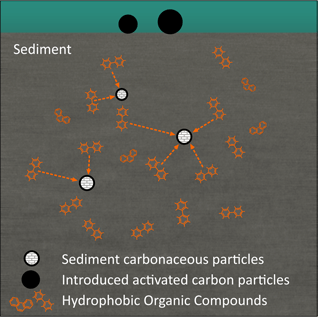OVERVIEW
Naturally occurring black carbons work because the structure of these pyrogenic particles has a high internal and external surface area (Koelmans et al., 2006). The HOCs are fixed first by physical occlusion inside the pore space within the particles, and after those are occupied, further sequestration occurs on the exterior and pore surfaces.
As illustrated in the figure, amending or thin capping the bioactive surface layer of sediment with AC will transfer contaminants from the sediment to the strongly binding AC particles, reducing bioavailability to benthic organisms and contaminant flux into the water column, and thus accumulation in the aquatic food-chain (Ghosh et al, 2011). Reduction in contaminant bioavailabiity has been demonstrated for PCBs, PAHs, pesticides (e.g., DDT), phthalates, and other HOCs.
AC works by stripping and tightly binding organic contaminants such as PCBs, pesticides from the water. Applying this same principle, research funded by SERDP demonstrated that adding precise doses of AC into sediments has the same effect; organic contaminants are bound up and are then not available for uptake into organisms.
|
|
- Natural black carbon particles sequester PCBs, reducing bioavailability
.
- Addition of AC alters PCB bioavailability.
- This reduction in bioavailability has been demonstrated for PCBs, PAHs, and DDT.
|



